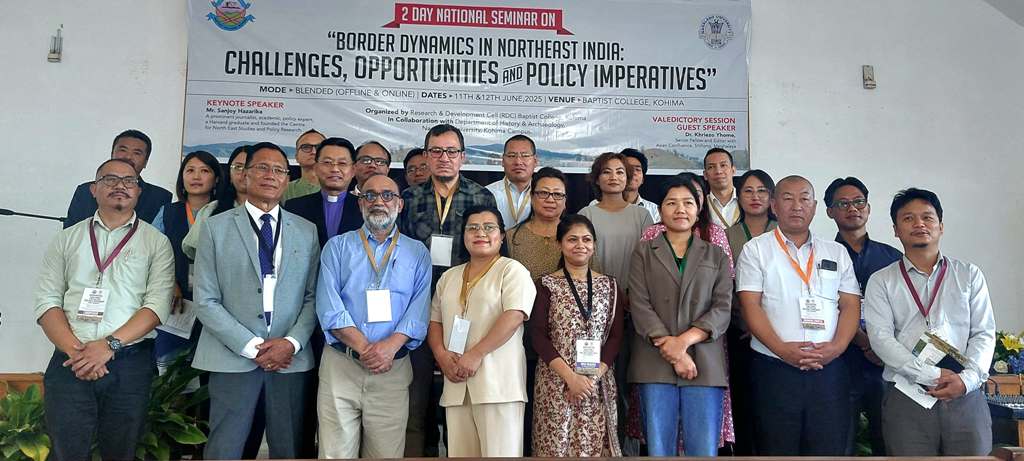SUNDAY, JUNE 15, 2025
- Home
- Experts call for inclusive policy and dialogue on Northeast India’s border dynamics
Experts call for inclusive policy and dialogue on Northeast India’s border dynamics
Experts at a Kohima seminar stress inclusive policy, stakeholder dialogue, and regional unity on Northeast India's border dynamics.
Published on Jun 11, 2025
Share
- KOHIMA — A two-day national seminar on ‘Border Dynamics in North-East India: Challenges, Opportunities and Policy Imperatives’, organised by the Research and Development Cell (RDC), Baptist College, Kohima, in collaboration with the Department of History and Archaeology, Nagaland University, Kohima Campus, got underway in Kohima on Wednesday.
- Delivering the keynote address at the inaugural function, Sanjoy Hazarika, journalist, author and founder of the Centre for North East Studies and Policy Research, emphasised the need for unity in Naga society while respecting each other’s history.

- Sanjoy Hazarika, Vipralhou Kesiezie and others on Wednesday at Rivenburg Hall, Kohima. (EM Images)
- Observing that there are no fewer than 28 political groups in Nagaland today, from what was once a single group representing the Naga cause, he highlighted the fatigue and uncertainty among people as political talks continue without resolution.
- Despite this, he reminded hat there are inspiring examples from the Naga Hills of how communities have dealt with conflict, violence and division through healing, steadfastness and mutual respect.
- Hazarika urged participants to explore such stories of peace, adding that political solutions, though critical, must be supported by restoration at various levels.
- Touching on concerns of the youth today, he noted that their attention is focused on four major issues—the recent controversy over 147 backdoor appointments, the issue of Illegal Bangladeshi Immigrants (which he found a puzzling term), the extension of the Inner Line Permit (ILP) to Dimapur, and the Indo-Naga political dialogue which, he said, has receded into the background except during official statements and visits.
- He observed a general fatigue among collectors, reconciliation workers, the public, and political actors—and pointed out that the Government of India (GoI) would likely prefer to sign an accord with one united Naga group rather than multiple factions. While stressing that it is not his role to suggest specific actions, he stated that all stakeholders must be consulted in a transparent and equitable manner.
Also read: Neiphiu Rio calls for accountability in central fund use at Viksit Nagaland meeting
- Commenting on the Free Movement Regime (FMR) and the proposed Indo-Myanmar border fence, Hazarika emphasised the importance of continuous dialogue with all stakeholders to ensure mutual understanding of priorities and perceptions.
- He added that the government must clearly communicate its “red lines,” as concerns around national security are valid, especially in the context of substance abuse, livelihood loss, divided families, and disrupted communities. Sharing from his broader experience, he said that “trust is the missing and often forgotten factor” that makes it difficult to find common ground without genuine engagement.
- He noted that in 2024, the GoI announced plans to construct a 1,600 km-long fence along the Indo-Myanmar border and gradually phase out the FMR, citing national security concerns, particularly the inflow of illegal immigrants, drugs, and arms—a demand strongly raised by the Manipur government.
- He mentioned that the entire project, including a paved patrol track and hybrid surveillance systems, is estimated to cost INR 31,000 crore over a span of 10 years—surpassing Nagaland’s annual budget. He also pointed out that the FMR, which had been in place since 1968 to allow limited cross-border movement, faced strong opposition from Nagaland and Mizoram, though it was supported by Manipur, Arunachal Pradesh, and Tripura.
- Subsequent policy changes reduced the permissible travel distance to 10 km, shortened the duration of stay, and introduced biometric QR code passes, deeply impacting communities with kinship, trade, and land ties across the border.
- Suggesting that a combination of drones, smart surveillance technologies, and limited human patrols could be more cost-effective and less intrusive, Hazarika said the terrain would make physical fencing both challenging and damaging.
- He also cautioned that the fence would require a buffer zone of 500 metres to 1 km within Indian territory, leading to land loss for locals. “History has to be respected even if it is not realised,” he stated.
- While delivering the inaugural address, Vipralhou Kesiezie, chairman of the governing body, Baptist College Kohima, said that border issues remain a shared concern across the entire Northeast region. Describing the region as highly vulnerable to both internal and external threats, he said that the rapid and fundamental changes taking place today pose serious risks if not addressed promptly.
- He stated that British colonisation had drastically altered the course of Naga political history, asserting that the Nagas lived as a free and independent people prior to annexation. He argued that political boundaries created without the consent of indigenous communities led to multiple insurgent movements.
- Kesiezie also put forward a number of suggestions for the region’s future. He said internal disputes should be resolved through peaceful negotiation and mutual compromise, and that the Northeast must form a united front to collectively pursue common regional concerns with the central government. This includes seeking rightful dues from the Centre, ensuring security, and addressing illegal immigration.
- He further stressed the importance of improving inter-state connectivity through enhanced road, rail, and air infrastructure; promoting cultural exchange in arts, sports, and literature; collaborating on tourism and recreational initiatives; developing a common regional language; and setting up trade centres across all NE states to boost the regional economy.

